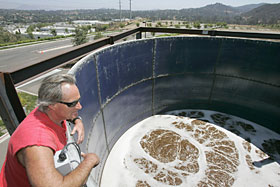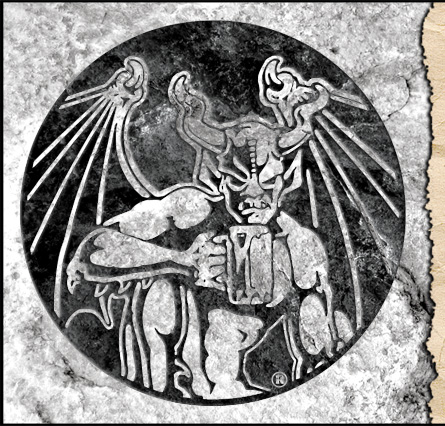 August 11th, 2008
Going Green . Stone Brewing . Waste Water Treatement
August 11th, 2008
Going Green . Stone Brewing . Waste Water Treatement
Stone Brewing Company installs waste water treatment plant

Background: Escondido’s Stone Brewing Co. has been trucking 40,000 gallons of wastewater every month to San Diego for treatment because Escondido’s municipal sewage treatment plant cannot handle its high sugar and protein content.
What’s changing: The brewery has spent $850,000 to build its own wastewater treatment facility. It will begin operating Wednesday.
Â
Â

Brewery will start treating wastewater
On-site facility will save hundreds of thousands of dollars
By Angela Lau – UNION-TRIBUNE STAFF WRITER
ESCONDIDO – These days, Escondido’s Stone Brewing Co. is not just brewing beer. It’s also simmering a stew of industrial-strength bugs, in tanks far removed from the barley and hops, to treat sewage.
The brewery is taking a detour from its traditional operations and will soon begin treating its own wastewater to save money. It had been spending hundreds of thousands of dollars each year to truck beer residue laden with sugar and proteins to San Diego for treatment.
That’s because of a glitch in the local wastewater treatment chain.
Escondido’s municipal wastewater treatment plant, which is nearing capacity, cannot handle all of the brewery’s concentrated wastewater because it contains too many dissolved solids, which require intensive treatment.
The city limited the brewery to no more than 25,000 gallons a day. The rest had to be shipped out by truck.
The brewing company had no idea it would face a wastewater quandary when it decided to move its operations from San Marcos and bought 3 acres at 1999 Citracado Parkway, said Steve Wagner, president and brew master.
“We found out about it in the later stages of moving here,†he said.
That was December 2005.
Soon after the brewery opened, it began spending as much as $12,000 a month to truck 40,000 gallons of wastewater to a San Diego treatment plant.
In the meantime, the brewery continued to grow. Its production of beer grew every year, from 12,400 gallons in 1996 to 2.1 million gallons last year. It is now ranked 20th in the nation in craft-beer sales by the Brewers Association, a Boulder, Colo.-based trade organization.
Despite the soft economy, the real estate market crash, high gas and food prices, and all the belt-tightening surrounding them, Wagner predicts more growth this year, topping 2.7 million gallons.
His optimism was borne out by the Brewers Association’s statistics, which showed a 6.5 percent increase in craft-beer sales nationwide in the first half of this year, compared with the first half of last year.
It doesn’t mean consumers are drowning their sorrows in beer, Wagner said. People are switching from macrobrewed beer, such as Budweiser, to craft beer, he said.
That has translated to more beer waste and expense for Stone.
So three months ago, the brewery spent $850,000 to install two wastewater treatment tanks adjacent to the brewery. One is 30 feet tall and 22 feet in diameter, the other 25 by 17.
While other larger breweries, such as New Belgium Brewing Co. in Fort Collins, Colo., boast of going green with their wastewater treatment facilities, Wagner said his decision was aimed at the bottom line.
“We had no choice,†he said.
Inside the bigger tank are Wagner’s heroes – large quantities of bacteria.
To prime the system, Stone borrowed 3,000 gallons of sludge from the city of Escondido and poured it into the big tank. Workers then tended to it with the same kind of precision they used in making beer.
First, they added a small amount of beer wastewater to the sludge to allow the bacteria to acclimate. Each day they added more, along with phosphorus as a nutrient.
By Wednesday, the tank should be teeming with bacteria ready to gorge on beer residue, producing the brewery’s first gallon of lower-strength wastewater, Sherwood said.
The effluent will be diluted enough to be sent to Escondido’s sewage treatment plant.
“If it goes as planned, they will be able to discharge the full amount to us without a problem,†said John Burcham, the city’s deputy utilities manager.
Wagner wants to take his wastewater enterprise a step further.

He is applying for permits to add filtration systems to produce the ultimate prize – recycled water that can be used to irrigate the brewery’s expansive landscaping. It guzzles up to 5,000 gallons of potable water a day now because Escondido does not produce enough recycled water.
But that still is not enough for Wagner. His goal is not to use the city’s sewage treatment plant at all.
To get there, Wagner is negotiating with the brewery’s next-door neighbor, Palomar Medical Center West, a hospital under construction, to sell Stone’s recycled water to irrigate the hospital’s 9.3 acres of landscaping. The hospital’s owner, Palomar Pomerado Health, is eager to go green.
“We are in informal discussions about how we can use their nitrogen-rich water for irrigation,†said Andy Hoang, Palomar Pomerado Health’s spokesman. “We want to be the leader of sustainability and conservation.â€